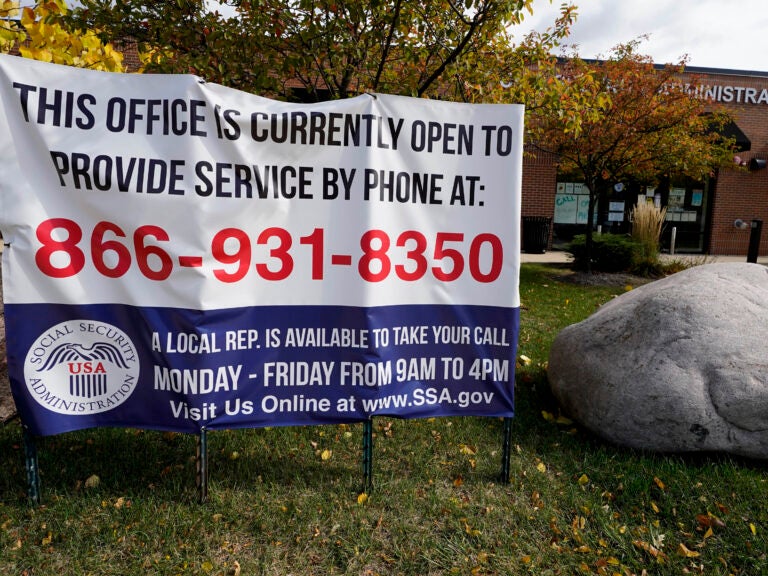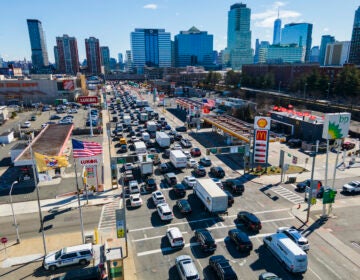Huge drop in federal aid for the poorest is blamed on closed Social Security offices

A sign outside a U.S. Social Security Administration office in Mount Prospect, Ill., in October last year. Closed SSA offices across the country are being blamed for a 30 percent drop in applications for an aid program for the most vulnerable. (Nam Y. Huh/AP Photo)
Growing up in Russia, Elena Muraveva was taught the importance of self-reliance.
“I really don’t like to complain,” she said.
But her days are now defined by debilitating pain and frequent migraines. It’s the result of a years-long battle with breast cancer that has also left Muraveva, 52, unable to work.
So she was relieved last year to learn she might qualify for disability benefits. She was given a piece of paper with the address of her local Social Security Administration field office in Philadelphia.
There, she could apply for Supplemental Security Income, or SSI. This benefit program provides monthly payments to about 8 million seniors and people with disabilities who have very limited income and little to no financial resources.
But before Muraveva made it to her field office, the pandemic struck and the SSA closed their 1,200 field offices across the country. For Muraveva, it’s been a frustrating year of trying to apply and hitting roadblocks at every turn. She’s just recently submitted her paperwork, and she still doesn’t know whether she qualifies.
Muraveva’s struggle to apply is not unique. During the pandemic, the number of monthly SSI applications and new benefit awardees has declined sharply. New data show that the number of new SSI awards given in January was the lowest on record — but it wasn’t because there were fewer people in need of the benefits.
“The agency has a crisis on its hands,” said David Weaver, who is now retired but worked for the SSA for over 20 years. Most recently, he led the SSA’s Office of Research, Demonstration and Employment Support, which conducts research on the SSI program.
“The people who are missing out are among the most vulnerable,” said Jonathan Stein, an advocate for those in poverty and, formerly, a legal aid lawyer at Community Legal Services of Philadelphia, which helps individuals apply for SSI benefits. “They are at enormous risk of eviction, utilities being shut off, homelessness, being deprived of food and necessities of life.”
Stein has watched with growing alarm as the numbers have dropped. He believes the situation created by the pandemic has exposed and exacerbated existing problems in the SSI system.
However, advocates say, this is an opportunity: If the SSA can figure out how to address the current situation, that may increase access to the program even after the pandemic.
Shuttered field offices
When she was told about the SSI program, Muraveva was eager to go to the SSA field office and apply, despite knowing no English.
A recent refugee from Russia, she arrived in Philadelphia in the summer of 2019 with her husband and son, neither of whom speak English. Yet, they were confident that they could navigate the field office with the help of SSA representatives.
“We thought we could do it easily. Or at least, there’d be someone there we could ask where to go and what to do,” Muraveva said through a translator.
In 2019, 43 million people across the country visited an SSA field office. That’s where many people found out about the SSI program and got help applying.
“Those were very busy places. Sometimes it would be hard to find a parking spot in the lot,” said James Winston, a lawyer in western Massachusetts, who helps people who have been denied disability benefits appeal the decision. “You would go in there, and it would be packed.”
But Muraveva never made it to the field office. With COVID-19, the SSA shifted in-person services to telephone services. So, Muraveva worked up the courage to ask a neighbor to help her navigate the SSA phone line.
“We call and it’s like, ‘You’re 250th in line. Please wait.’ And we wait and wait and wait,” she said. “She and I never reached a point where someone would talk to us.”
Muraveva and her neighbor tried several times but soon COVID-19 meant it wasn’t safe to see anyone outside your household. Muraveva called the SSA number herself, using Google Translate to understand the phone prompts. That didn’t work. She found a Russian phonebook and called lawyers for help. That didn’t work either.
After nearly a year of trying, Community Legal Services of Philadelphia helped her submit her paperwork.
“This is a very typical story,” said Stein, who worked at the legal aid service for over 50 years.
Some potential SSI recipients are turning to legal aid groups for help, others are turning to lawyers — who take a cut of the benefits awarded — and still others are missing out entirely.
New benefit awards for SSI are down nearly 30 percent during the pandemic, compared to the same period last year.
Kathleen Romig, a senior policy analyst at the Center for Budget and Policy Priorities, says the explanation for the sharp decline is simply and solely the closed field offices. She says a lot of people used to go there and get help with their SSI applications.
“It’s much more complicated to apply for a disability benefit than it is to apply for retirement or survivor’s benefit,” said Romig.
She points out that, unlike SSI benefits, applications for retirement benefits – which can be done online – have not seen a major drop during the pandemic.
The SSI application – which generally cannot be completed online – requires an individual to prove their age or medical impairment as well as their financial situation. If an individual has a penny over $2,000 in the bank, they don’t quality.
Who is missing out
The drop in applications and awards has not been evenly distributed. There’s been a particularly steep drop off in applications in New York, Philadelphia, Boston and San Francisco. And, Romig says, two groups seem to have been especially hurt by the shuttered field offices: non-English speakers and people who are over 65 years old.
“It’s really important for those people to have this in-person option and that’s something that hasn’t been available for nearly a year now,” Romig said.
Weaver estimates that, because of the drop in new recipients during the pandemic, more than 120,000 low-income Americans have already missed out on the payments. But, he says, it’s not just about the money. In most states, when a person qualifies for SSI, they are automatically eligible for Medicaid, too.
“So, you have a population of disabled individuals and seniors missing out on cash benefits from SSI and missing out on health benefits as well,” Weaver said.
Romig wants to see the SSA do more to make up for the lack of in-person services.
“We’re not seeing a really robust effort yet and we’re really hoping that the agency will undertake one,” she said.
On Feb. 11, SSA Commissioner Andrew Saul acknowledged the drop in applications in an email to all SSA employees.
In a statement to NPR, SSA spokesperson Mark Hinkle said, “We know vulnerable populations, especially the SSI population, rely on in-person service. We stepped up our outreach with advocates and third-party organizations to get their perspective about how things are going and to ask them for ideas on how we could improve our service during the pandemic.”
He said the SSA is developing a training so caseworkers in the community can help with applications. The agency is also in the process of producing radio, TV and social media ads to raise awareness.
Not an entirely new issue
Advocates for seniors and people with disabilities say SSI’s current predicament is an opportunity to fix a problem that existed long before the pandemic.
Since the program began in 1974, many of those who are eligible have not gotten benefits. A 2015 study from the University of Michigan found that half of all people eligible for SSI are missing out.
Weaver said there are two main reasons: “They don’t know about it, or the application process is too challenging.”
He’s been brainstorming what to do.
For starters, he says, the SSA has a large database of Americans, and they know who would likely qualify. He points to research showing that mass mailings informing seniors who would likely qualify about the program could boost enrollment substantially. Plus, Weaver says, it’s not hard to send out the letters.
“That’s very easy to do,” he said. “The agency sends out probably a million notices a day for various purposes.”
He has another idea, too: Team up with organizations who serve seniors and people with disabilities, such as the AARP and community health centers. Given them brochures to share, and teach them about the program.
Weaver says a lot is riding on getting this right. The people who are missing out on benefits are among the poorest in the country and those at highest risk in the pandemic. And if reforms are implemented it could be helpful even after field offices reopen.
9(MDAzMzI1ODY3MDEyMzkzOTE3NjIxNDg3MQ001))




